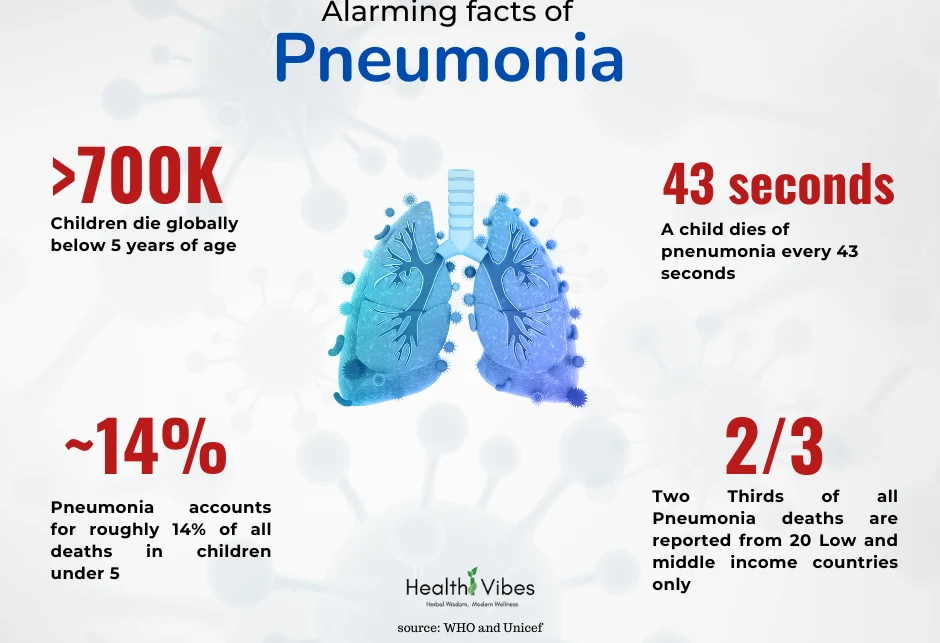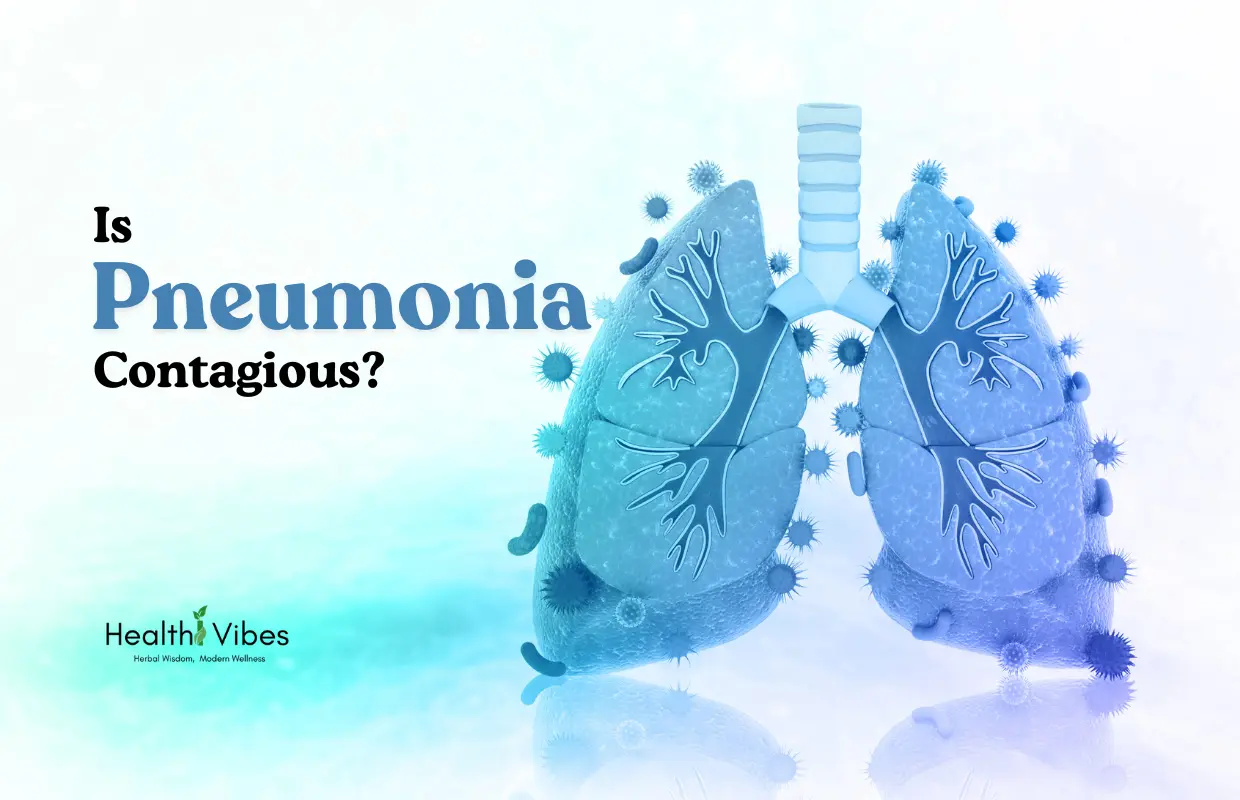Is pneumonia contagious? The answer to the frequently asked question is yes and no. Lets understand why?
What is Pneumonia?
Pneumonia is a type of lung infection caused by different types of bacteria, viruses or fungi. The infection causes inflammation in the lung air sacs called “alveoli”. It results in buildup of fluid or pus in the sacs which causes chest pain with difficulty in breathing with yellow to green cough with or without high grade fever with chills.
Pneumonia can affect one or both lungs depending on the severity. If both lungs are affected than it is called “Bilateral Pneumonia”. It is a severe form of pneumonia. Pneumonia’s severity varies from can be mild to deadly. It’s particularly dangerous for infants, young children, people over 65, and anyone with existing health issues or a compromised immune system.
Types of Pneumonia
How you acquire pneumonia infection can be broadly classified into following categories:
Community Acquired Pneumonia (CAP):
When you get infected from pneumonia outside of a hospital or healthcare facility, it is known as Community Acquired Pneumonia. It is mainly caused by inhaling or coming in direct contact of infected respiratory droplets of an infected individual.
Causes of CAP pneumonia can be broken down into three main categories of pathogens: bacteria, viruses, and fungi. Each of these germs has a distinct method of transmission and impact on the body.
Bacterial Pneumonia
Bacterial pneumonia is the most common type of pneumonia affecting adults primarily. It often more serious than viral pneumonia especially in children and adults with weakened immune systems.
Common symptoms include cough, high grade fever, difficulty breathing, chest pain, fatigue or confusion.
Transmission:
Bacterial pneumonia is highly contagious and is primarily spread through respiratory droplets when an infected person coughs, sneezes, or talks. These droplets can be inhaled by others, leading to a new infection. While less common, the infection can also be spread by touching a contaminated surface and then touching your mouth or nose.
Common Bacteria
Several types of bacteria can cause pneumonia, with some being more common than others. The most frequent culprits include:
- Streptococcus pneumoniae: The most common cause of bacterial pneumonia in both children and adults.
- Haemophilus influenzae: A significant cause, especially in young children.
- Staphylococcus aureus: Can cause a severe, rapidly progressing form of pneumonia, often a concern in hospital settings.
- Mycoplasma pneumoniae: A common cause of “walking pneumonia,” a milder form of the disease.
- Chlamydia pneumoniae: Often causes mild pneumonia.
- Legionella pneumophila: Known for causing Legionnaires’ disease, a severe type of pneumonia

Viral Pneumonia:
Viruses are the second most common cause of pneumonia. This type is often less severe than bacterial pneumonia and may resolve on its own, but it can still be a serious illness.
Viral pneumonia occurs when a respiratory virus, like the flu, enters the lungs and multiplies. This viral invasion triggers an immune response that causes inflammation in the airways and alveoli
Common symptoms may be similar to common flu or common cold by may increase severity quickly.
Transmission:
Viral Pneumonia is also highly contagious and spread by same methods as bacterial pneumonia via respiratory droplets from an infected person.
Common pneumonia viruses:
A variety of viruses can cause pneumonia, with some being more common in specific age groups. The most frequent culprits include:
- Influenza virus (flu): A very common cause in both children and adults.
- Respiratory syncytial virus (RSV): The most common cause of viral pneumonia in young children and infants.
- SARS-CoV-2 (COVID-19): Can cause severe pneumonia in individuals of all ages.
- Adenovirus: Known to cause respiratory infections that can lead to pneumonia.
- Parainfluenza virus: A common cause of respiratory infections in young children that can progress to pneumonia.
Fungi
Fungal pneumonia is a lung infection caused by various types of fungi. Unlike bacterial or viral pneumonia, it is not a common disease in healthy individuals. It most often affects people with weakened immune systems or those who have been exposed to a large number of fungal spores from the environment.
Fungal pneumonia is caused by inhaling microscopic fungal spores from the air, which then grow in the lungs. Fungi that cause pneumonia are typically found in specific geographic regions and habitats, such as soil contaminated with bird or bat droppings, decaying wood, or desert soil.
The symptoms of fungal pneumonia are often similar to those of bacterial or viral pneumonia, but they can be chronic and may not improve with standard antibiotic treatment
Transmisson:
Fungal pneumonia is not contagious and cannot be spread from person to person. The infection is acquired directly from the environment by inhaling fungal spores from the air.
Common fungal species:
Fungi rarely cause disease in healthy people but can cause severe infection in those with compromised immune systems. Examples include:
Candida and Cryptococcus: Fungi that can lead to pneumonia in immunocompromised patients.
Pneumocystis jirovecii: A common cause of pneumonia in people with HIV/AIDS.
Aspergillus: A mold that can cause a severe form of pneumonia, especially in hospital settings.
Hospital Acquired Pneumonia (HAP)
Hospital-acquired pneumonia (HAP), also known as nosocomial pneumonia, is a serious lung infection that develops at least 48 hours after a patient has been admitted to a hospital or other healthcare facility and was not incubating at the time of admission. HAP is often more severe than community-acquired pneumonia because the pathogens involved are frequently more virulent and resistant to common antibiotics.
Transmisson
HAP does not spready as easily as Community Acquired pneumonia. It is mainly spread by Aspiration or contaminated surface and equipment like ventilators or even hands of the healthcare workers.
Common Pathogens
The pathogens that cause HAP are often more aggressive and antibiotic-resistant than those causing community-acquired pneumonia. The most common bacteria include:
- Pseudomonas aeruginosa: A highly resistant and virulent Gram-negative bacterium, a major cause of pneumonia in intensive care units (ICUs).
- Staphylococcus aureus: Particularly methicillin-resistant S. aureus (MRSA), which is a significant and difficult-to-treat cause.
- Enterobacteriaceae: A family of Gram-negative bacteria that includes Klebsiella pneumoniae and Escherichia coli, which are common culprits, especially in ventilator-associated pneumonia (VAP).
- Acinetobacter species: Another group of multidrug-resistant Gram-negative bacteria that are frequently isolated in HAP cases.
Ventilator-associated pneumonia (VAP)
Ventilator-associated pneumonia (VAP) is a severe lung infection that develops in a patient who has been on mechanical ventilation for more than 48 hours. d life-threatening infections in intensive care units (ICUs). VAP significantly increases the duration of hospital stay, healthcare costs, and the risk of mortality.
The same types of bacteria as community-acquired pneumonia, as well as the drug-resistant kinds that cause hospital-acquired pneumonia, cause VAP.

Aspiration pneumonia
Aspiration pneumonia is a serious lung infection caused by inhaling food, saliva, vomit, or stomach contents, into the lungs. This type of pneumonia is not caused by the typical spread of a pathogen from person to person but rather by a failure of the body’s natural defense mechanisms to prevent the inhalation of this material.
Is Pneumonia Contagious?
The simple answer is yes and no. You will not be able to pinpoint if the person near you is carrying contagious pneumonia strain until they get tested. So, unless you know the reports of infected person, treat every individual with symptoms of pneumonia as potentially contagious. This is also true since most of the pneumonia pathogens, as mentioned earlier, are highly contagious especially if it is bacterial pneumonia.
Takeaway?
Your safety is your hands. Avoid close proximity with infected individuals with symptoms resembling pneumonia. Also take precautions with wearing masks and avoid touching surfaces in contact with the infected individuals.
Additionally, Flu like symptoms increase at the starting of winter season. The best way to avoid infection to keep you immunity up. Avoid cold drinks, drink hot liquids as much as possible, keep your body warm and try to include some herbal drinks to boost immunity if you can. At the end, a healthy body will fight the infection more efficiently.
Disclaimer
This article is for educational purposes only. It is based on information from peer-reviewed research, respected medical organizations, and clinical experts. It is not a substitute for professional medical advice, diagnosis, or treatment.
If you have symptoms of pneumonia—such as fever, cough, chest pain, or shortness of breath—please contact a qualified healthcare provider right away. Always seek the guidance of your doctor or another licensed health professional regarding any medical condition or before starting new treatments.
Sources : WHO and Unicef

